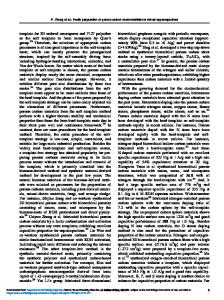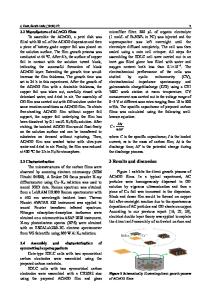Carbon nanotubes/graphitic carbon nitride nanocomposites for all-solid-state supercapacitors
- PDF / 3,727,463 Bytes
- 7 Pages / 595.276 x 793.701 pts Page_size
- 70 Downloads / 344 Views
rbon nanotubes/graphitic carbon nitride nanocomposites for allsolid-state supercapacitors 1
1,2*
LU Chao & CHEN Xi 1
Department of Earth and Environmental Engineering, Columbia University, New York 10027, USA 2 School of Chemical Engineering, Northwest University, Xi’an 710069, China Received November 28, 2019; accepted March 5, 2020; published online July 21, 2020
All-solid-state supercapacitors with high power density and working stability are high-efficiency energy storage devices for smart electronic equipment. Developing electrode materials with fast ions and electrons transport is critical to improving the energy storage capability. Here, we report carbon nanotubes/graphitic carbon nitride nanocomposites with large specific surface area, porous structure and high electrical conductivity toward high-performance supercapacitors. The large surface area with porosity provides reservoir for ion accommodation during charge-discharge processes, and the high conductivity facilitates electrons and ions transport. Furthermore, nitrogen sites in electrodes contribute significant pseudocapacitance for super–1 –1 capacitors. The nanocomposites based device gives a high specific capacity of 148 F g at current density of 1 A g with good –1 rate capability from 1 to 10 A g . Additionally, the device displays excellent working stability with capacitance retention of 93% –1 even after 10000 cycles at 1 A g under 0.8 V in air. This study sheds light on design of nanocomposites with highly efficient charge transfer and will accelerate development of next-generation solid state energy devices. carbon nanotubes, graphitic carbon nitride, nanocomposite, nitrogen doping, high capacity, supercapacitors Citation:
1
Lu C, Chen X. Carbon nanotubes/graphitic carbon nitride nanocomposites for all-solid-state supercapacitors. Sci China Tech Sci, 2020, 63, https://doi. org/10.1007/s11431-019-1554-x
Introduction
All-solid-state supercapacitors have attracted enormous attentions these years due to the high power density, scalability, lightweight, and working stability [1–3]. It is well known that electrochemical performances of supercapacitors are mainly determined by physical and chemical properties of electrode materials [4–6]. The ideal candidates should satisfy at least two property requirements, including specific surface area and electrical conductivity. Large specific surface area will provide enough space for ion accommodation and improve energy density of devices [7,8]. And more, conductivity of electrode materials is another key parameter for supercapacitors because charges collected need to be *Corresponding author (email: [email protected])
transferred fastly to achieve good rate performances [9,10]. Electronic structure regulation of electrode materials through heteroatom doping are effective for enhancement of charge conductivity in supercapacitors [11,12]. Another effective method is to introduce highly conductive materials into electrode systems, including carbon nanotubes (CNTs), metal nanowires and graphene [13,14].
Data Loading...











